128 books about Baseball and 5
start with H
128 books about Baseball and 5
128 books about Baseball
5 start with H start with H
5 start with H start with H
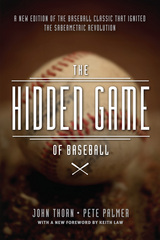
The Hidden Game of Baseball
A Revolutionary Approach to Baseball and Its Statistics
John Thorn, Pete Palmer, with David Reuther
University of Chicago Press, 2015
Long before Moneyball became a sensation or Nate Silver turned the knowledge he’d honed on baseball into electoral gold, John Thorn and Pete Palmer were using statistics to shake the foundations of the game. First published in 1984, The Hidden Game of Baseball ushered in the sabermetric revolution by demonstrating that we were thinking about baseball stats—and thus the game itself—all wrong. Instead of praising sluggers for gaudy RBI totals or pitchers for wins, Thorn and Palmer argued in favor of more subtle measurements that correlated much more closely to the ultimate goal: winning baseball games.
The new gospel promulgated by Thorn and Palmer opened the door for a flood of new questions, such as how a ballpark’s layout helps or hinders offense or whether a strikeout really is worse than another kind of out. Taking questions like these seriously—and backing up the answers with data—launched a new era, showing fans, journalists, scouts, executives, and even players themselves a new, better way to look at the game.
This brand-new edition retains the body of the original, with its rich, accessible analysis rooted in a deep love of baseball, while adding a new introduction by the authors tracing the book’s influence over the years. A foreword by ESPN’s lead baseball analyst, Keith Law, details The Hidden Game’s central role in the transformation of baseball coverage and team management and shows how teams continue to reap the benefits of Thorn and Palmer’s insights today. Thirty years after its original publication, The Hidden Game is still bringing the high heat—a true classic of baseball literature.
The new gospel promulgated by Thorn and Palmer opened the door for a flood of new questions, such as how a ballpark’s layout helps or hinders offense or whether a strikeout really is worse than another kind of out. Taking questions like these seriously—and backing up the answers with data—launched a new era, showing fans, journalists, scouts, executives, and even players themselves a new, better way to look at the game.
This brand-new edition retains the body of the original, with its rich, accessible analysis rooted in a deep love of baseball, while adding a new introduction by the authors tracing the book’s influence over the years. A foreword by ESPN’s lead baseball analyst, Keith Law, details The Hidden Game’s central role in the transformation of baseball coverage and team management and shows how teams continue to reap the benefits of Thorn and Palmer’s insights today. Thirty years after its original publication, The Hidden Game is still bringing the high heat—a true classic of baseball literature.
[more]
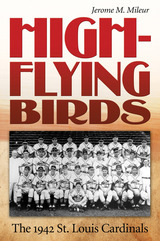
High-Flying Birds
The 1942 St. Louis Cardinals
Jerome M. Mileur
University of Missouri Press, 2009
1942: Americans suddenly found themselves at war but were not about to be distracted from the National Pastime. The Brooklyn Dodgers and New York Yankees were looking to continue their World Series rivalry from the 1941 season, and a youthful team from St. Louis was determined to stop them.
With only one player older than thirty, the St. Louis Cardinals were the youngest team to win the National League pennant and World Series. Built on good pitching and tremendous speed on the base paths and in the field, the team featured rookie Stan Musial, future Hall of Famer Enos Slaughter, and ace pitcher Mort Cooper, the National League’s Most Valuable Player of 1942. With their winningest season ever, posting 106 victories, the 1942 Redbirds have been called the greatest Cardinal team of all time.
Jerome Mileur was just a kid from downstate Illinois, but he well remembers his view of one game from the left-field grandstand—and the thrill of attending the second game of the World Series. In this book, he brings a sure and loving grasp of his subject to reconstructing one of the most remarkable pennant drives in modern baseball history, with the Cards winning forty-three of their last fifty-one games and clinching first place on the last day of the season.
Mileur provides a game-by-game account of the season with play-by-play action, not only capturing all the thrills on the Cards’ way to the top but also conveying the physical and mental demands that the players endured. Counted out by nearly everyone but themselves in August, the Redbirds caught fire in the season’s final weeks to pass the seemingly unbeatable Dodgers. And by winning four games out of five to defeat the New York Yankees for the championship, they handed Joe DiMaggio his only World Series defeat.
More than a recapitulation of a thrilling season, Mileur’s book is a reminder of how major-league baseball in 1942 differed in so many ways from today’s game—one startling example is Mileur’s account of how the absence of outfield warning tracks contributed to a devastating injury to Brooklyn’s star outfielder, Pete Reiser. The tenor of the times is reflected as well in the juxtaposition of the baseball season with the United States’ first year in the Second World War.
The 1942 Cardinals were not only a remarkable team unto themselves but also the beginning of a new baseball dynasty—1942’s pennant was the first of three in a row for the Cards, as well as the first of three World Series victories in a space of five seasons. This account of that tremendous season is a page-turner for anyone who loves the game and a must-read for Cardinals fans.
[more]
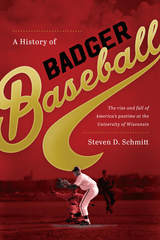
A History of Badger Baseball
The Rise and Fall of America's Pastime at the University of Wisconsin
Steven D. Schmitt
University of Wisconsin Press, 2017
For more than a century, the University of Wisconsin fielded baseball teams. This comprehensive history combines colorful stories from the archives, interviews with former players and coaches, a wealth of historic photographs, and the statistics beloved by fans of the game. The earliest intercollegiate varsity sport at Wisconsin, the baseball team was founded in 1870, less than a decade after the start of the Civil War. It dominated its first league, made an unprecedented trip to Japan in 1909, survived Wisconsin's chilly spring weather, two world wars, and perennial budget crises, producing some of the finest players in Big Ten history—and more than a few major leaguers. Fan traditions included torchlight parades, kazoos, and the student band playing "A Hot Time in the Old Town Tonight" as early as 1901.
There is painful history here, too. African Americans played on Wisconsin's first Big Ten championship team in 1902, including team captain Julian Ware, but there were none on the team between 1904 and 1960. Heartbreaking to many fans was the 1991 decision to discontinue baseball as a varsity sport at the university. Today, Wisconsin is the only member of the Big Ten conference without a men's baseball team.
Appendixes provide details of team records and coaches, All Big Ten and All American selections, Badgers in the major leagues, and Badgers in the amateur free-agent draft.
There is painful history here, too. African Americans played on Wisconsin's first Big Ten championship team in 1902, including team captain Julian Ware, but there were none on the team between 1904 and 1960. Heartbreaking to many fans was the 1991 decision to discontinue baseball as a varsity sport at the university. Today, Wisconsin is the only member of the Big Ten conference without a men's baseball team.
Appendixes provide details of team records and coaches, All Big Ten and All American selections, Badgers in the major leagues, and Badgers in the amateur free-agent draft.
[more]
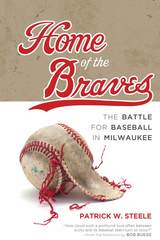
Home of the Braves
The Battle for Baseball in Milwaukee
Patrick W. Steele
University of Wisconsin Press, 2020
Winner of the Gambrinus Prize from the Milwaukee County Historical Society
In March 1953, the Boston Braves relocated to Milwaukee. They soon found success with stars like Hank Aaron and Eddie Mathews. The team began drawing bigger crowds than almost any other and went on to win two pennants and a World Series within five years. To fans, it was the dawn of a new dynasty—making it even more of a shock when the owners announced in October 1964 that the Braves would move once again, this time to Atlanta. Patrick Steele examines all facets of the story to understand why the "Milwaukee Miracle" went south.
In March 1953, the Boston Braves relocated to Milwaukee. They soon found success with stars like Hank Aaron and Eddie Mathews. The team began drawing bigger crowds than almost any other and went on to win two pennants and a World Series within five years. To fans, it was the dawn of a new dynasty—making it even more of a shock when the owners announced in October 1964 that the Braves would move once again, this time to Atlanta. Patrick Steele examines all facets of the story to understand why the "Milwaukee Miracle" went south.
[more]
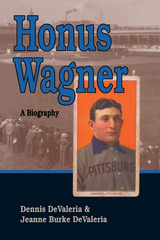
Honus Wagner
A Biography
Dennis Devaleria
University of Pittsburgh Press, 1998
With the coming of the twentieth century, America was thinking on a grand scale. Barriers of communication and transportation were being overcome and giants such as Andrew Carnegie, John D. Rockefeller, and William Randolph Hearst walked the land. The nation’s game was baseball, and its giant was Honus Wagner. In 1996, a baseball card depicting Honus Wagner sold for $640,500 - the largest sum ever paid at auction for a sports artifact. What could possibly make that piece of cardboard, approximately one-and-a-half by two-and-a-half inches, worth more than half a million dollars? The DeValerias tell the unique story behind this now-famous baseball card and the man depicted on it. In doing so, they accurately present the local, regional, and national context so readers gain a thorough understanding of Wagner’s times.Wagner’s gradual emergence from the pack into stardom and popularity is described here in rich detail, but the book also reveals much of Wagner’s family and personal life - his minor leauge career, his values, his failed business ventures during the Depression, and his later years. Neither the “rowdy-ball” ruffian nor the teetotal saint constructed of legend, Wagner is presented here in a complete portrait - one that offers a vivid impression of the era when baseball was America’s game and the nation was evolving into the world’s industrial leader.
[more]
READERS
Browse our collection.
PUBLISHERS
See BiblioVault's publisher services.
STUDENT SERVICES
Files for college accessibility offices.
UChicago Accessibility Resources
home | accessibility | search | about | contact us
BiblioVault ® 2001 - 2024
The University of Chicago Press









